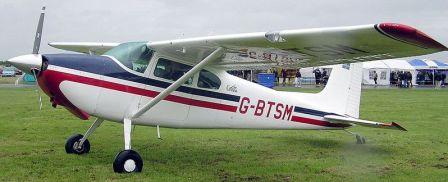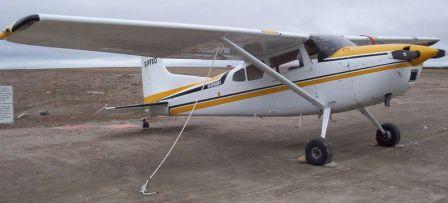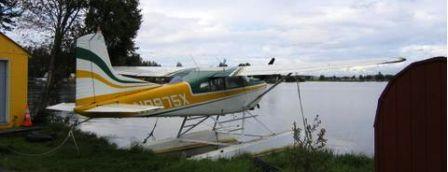Cessna 180s and 185s
Along with the Super Cub, Cessna 180s and 185s are considered to be prime bush planes. While the Cessnas will not offer the same short field abilities of the Super Cub, they will easily carry four adults. Some models are fitted with six seats but the last two seats are very small and cramped. Like the Super Cub, Cessna 180s and 185s are easily fitted with floats, skis or tundra tires. Cessna ceased producing the 180 in 1981 and the 185 in 1985.
A kit version of these planes has been offered as the “Cyclone” from a Canadian manufacturer, however the current availability of the Cyclone kit is unknown. Reportedly, 25 Cyclones have been manufactured. The Cyclone has a longer wing and accepts more powerful engines that the stock Cessnas. The Cyclone kit is offered by St-Just Aviation.

The 180 and 185 are very similar in appearance, but the 185 has a larger dorsal fin attached to its vertical surface (although some 180s were produced with the larger fins and others have been modified to its specifications). Both aircraft are constructed of 2024-T3 Alcad aluminum using a semi-monocoque design with rivet fasteners. While the design was produced easily on an assembly line, the exact construction of the 180 and 185 would likely make kit-construction of such a plane to be challenging at the very least.
Because of their outstanding bush flying abilities, Cessna 180s and 185s command premium prices on the used market. While extremely well worn examples may fetch prices of $50,000 or less, these airplanes typically sell in the $50,000 to $150,000 price range, depending upon condition and avionics. Extremely well refurbished examples regularly sell at prices exceeding $150,000. Because of these prices, wrecked and project planes are quickly snapped up by price-weary Cessna aficionados. Cessna aircraft parts are still widely available for the 180/185 series airplanes.
Except for the conventional landing gear, the 180 and 185 fly a good deal like the ubiquitous Cessna 182 of which most pilots are familiar. Both airplanes feature stable, vice-free, flying characteristics.
Cessna 180
Cessna began production of the 180 in 1953 as a more powerful and stout version of its 170 model. Both aircraft featured conventional landing gear and both were eventually fitted with tri-cycle landing gear (becoming the 172 and 182 respectively). 180s were factory-equipped with Continental 0-470 engines intially of 225 hp. Modifications allow installation of 300 hp engines.
This next video is a bit esoteric but some great eye candy. The Cessna 180 pilot has to follow some pretty sharp curves in the river to get enough speed for take off.
Cesna 185
Cessna introduced the 185 in 1961 as a more powerful version of the 180. Initally the 185 featured a 260 hp IO-470 Continental engine and in 1966 the engine was changed to a Continental IO-520 producing 285 hp. Modifications allow installation of engines up to 350 hp and, very rarely, a 185 will be seen with a small turbo-prop engine.

Both aircraft would cruise at speeds approaching 150 mph and had stalling speeds below 61 mph (slower with modifications). Several companies offered STOL (Short Take-Off and Landing) modifications for the Cessnas and these modifications ranged from simple drooped leading edge cuffs to dropped leading edge cuffs and drooping ailerons. The planes carried a full compliment of instruments and avionics and many non-bush pilots favored them for instrument flying as both were very stable airplanes in flight.

While neither Cessna offered the short field capabilities of the Super Cub, both were quite respectable in their ability to operate from short strips.
On balance, the Cessnas offer a good compromise between load- carrying abilities and short-field performance. The Cessnas do not offer the same short field performance of Super Cub (and similar aircraft) but they will easily carry four adults. Helio Couriers offer Super Cub-like performance for four adults, but the Couriers are rare, have engines that are expensive to maintain and can be challenging to maintain in general. Thousands of Cessna 180s and 185s were produced and parts availability does not appear to be a matter of great concern for the foreseeable future.

The video below is a Cessna 185 taking off from Johnson Creek, Idaho. The secenery is awesome.